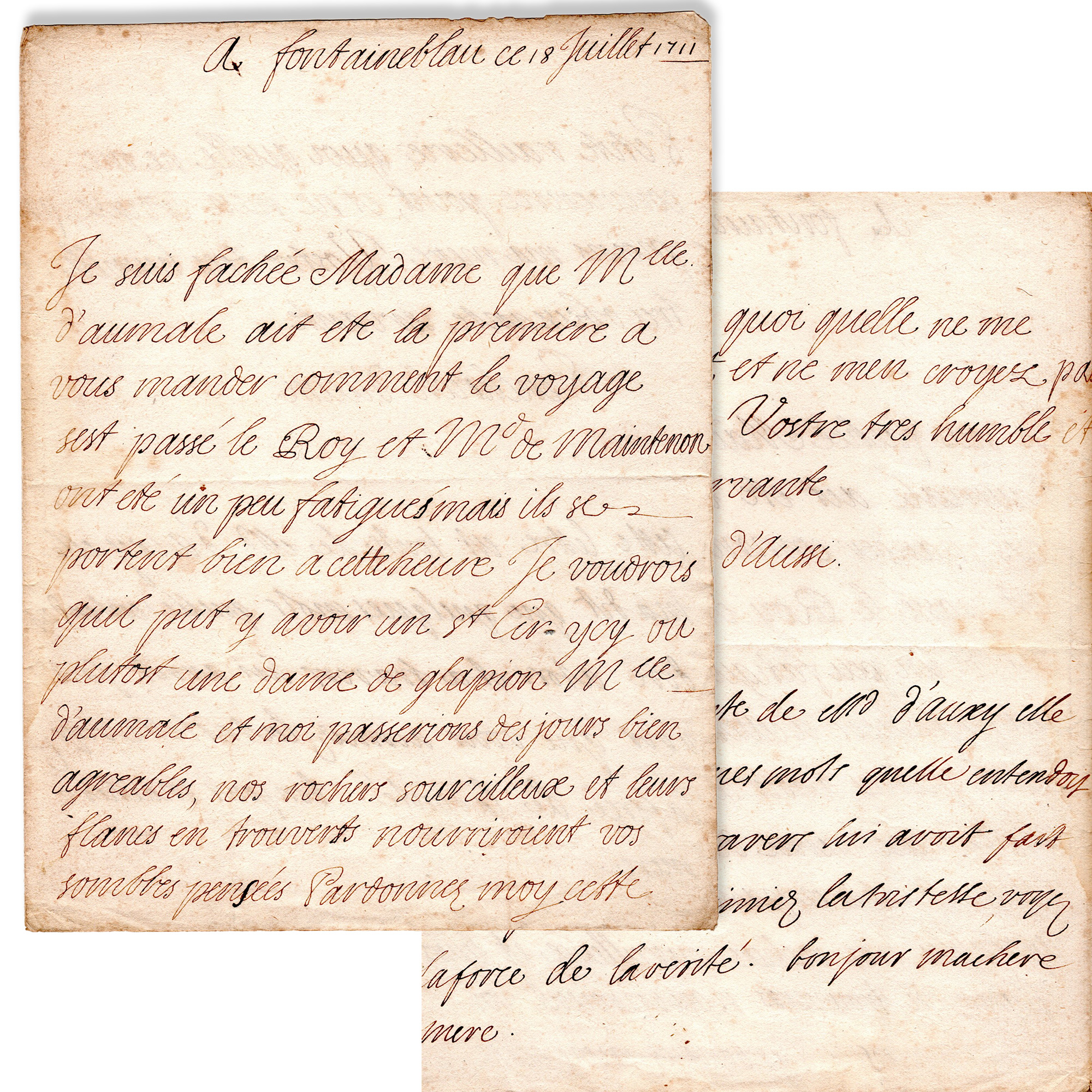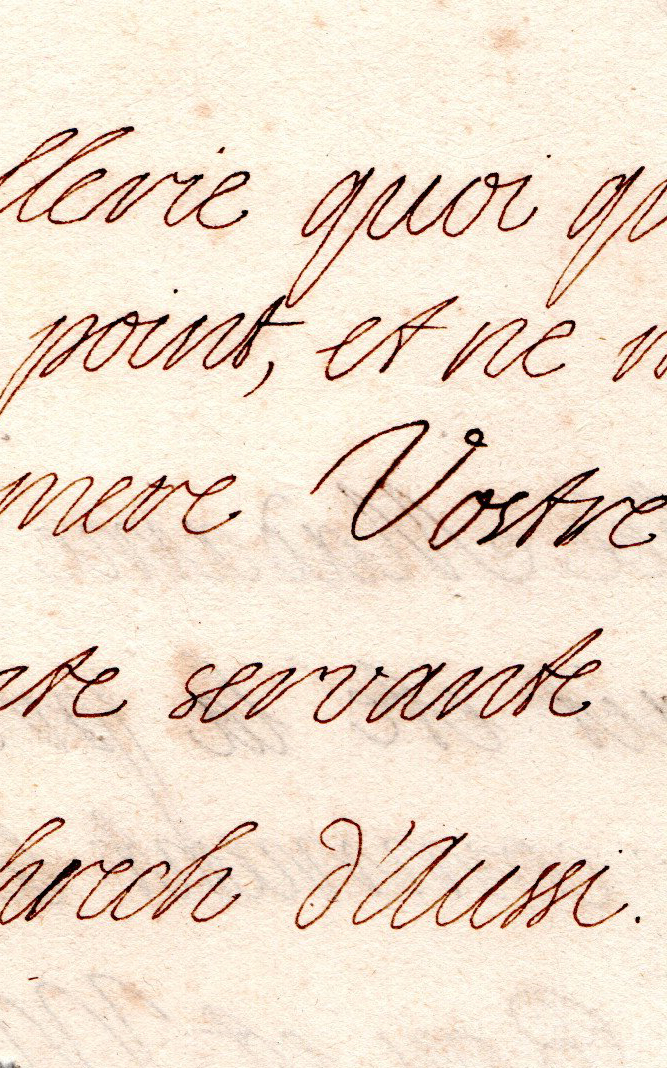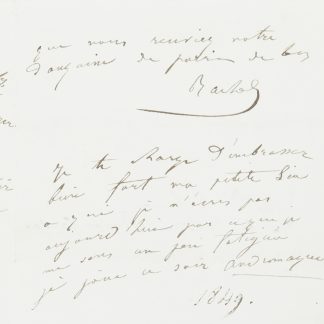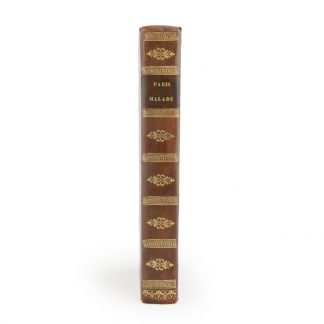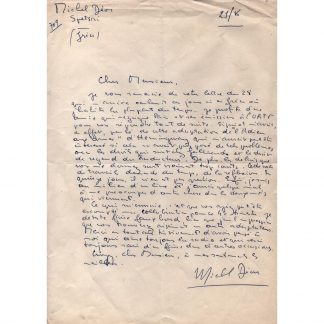Description
Autograph letter signed Pencherech d'Aussi, dated Fontainebleau 18 July 1711, addressed to Madame de Glapion.
PRECIOUS YOUTHFUL LETTER FROM A CHILD COLLECTED BY MME DE MAINTENON WHICH AMUSED THE KING
The daughter of a Breton gentleman, Jeanne-Thérèse de Penchrech (or Pincré) was taken in by Madame de Maintenon, who called her Jeannette, and had her married at the age of 13, on 11 March 1711, in the chapel of the Château de Versailles, to Étienne -Joseph d'Isarn de Villefort de Montjeu, Marquis d'Haussy (also known as Auxi or Ossi) Governor of Guérande.
"At Fontainebleau on 18 July 1711
I am sorry, Madame, that Mlle d'Aumale was the first to tell you how the journey went. The King and Mde de Maintenon were a little tired but they are doing well at the moment. I wish there could be a St Cyr here, or rather a lady from Glapion. Mlle d'Aumale and I would spend some very pleasant days, our thorny rocks and their half-open sides would nourish your venerable thoughts. Forgive me this little jibe, even though it does not suit me, and do not think me any less my mother. Your most humble and obedient servant
Penchrech d'Aussi
Post-Sciptum autograph of Mademoiselle d'Aumale :
"This letter is all from Md d'Auxy, she says a few words that she heard being said out of turn. She had made him see that you liked sadness, see the strength of the truth. Hello my dear mother.
Saint-Simon describes the case of little Jeannette in detail in volume 9 of his Memoirs :
« There was a small marriage which would seem to have to be omitted here, but whose singularities deserve a place here, that of Villefort with Jeannette. It doesn't promise much, and yet it's going to work. It is necessary to explain the characters: Villefort's mother was beautiful, tall and of good height; she lost her husband, an officer-major in I don't know what rank; she had nothing but children, or very little to share with them. She had wit and intrigue, but no gallantry, and virtue. She had a special recommendation from Mme de Maintenon, to whom she was introduced. Mme de Maintenon, like the king, was the person in the world who was most taken by her looks. She was touched by her modest, afflicted and unhappy appearance. She had her given a pension, took her under singular protection, found her witty; the figure sustained her. Her husband was a gentleman, and she a maiden. Mme de Maintenon called her only her beautiful widow, and made her one of the two sub-governors of the children of France. Jeannette was a young lady from Brittany whose name was Pincré; her father died and left his wife without bread with a bunch of tiny children. Reduced to begging, she came with them, as best she could, to throw herself on her knees at the carriage in which Mme de Maintenon was going to Saint-Cyr. She was charitable, asked about this unfortunate family, gave them something, placed the children, according to their age, where she could, and took a little girl who was still a child into her home, whom she placed with her wives until she had proved herself and was old enough to enter Saint-Cyr. This child was very pretty; she amused Mme de Maintenon's wives with her little cackle, and soon amused her herself. The king sometimes found her as she was being sent away, he caressed her, she did not frighten him, he was delighted to find a pretty little child whom he did not frighten, he became accustomed to bantering with her, so much so that when there was talk of putting her in Saint-Cyr, he did not want to. As she grew older, she became more amusing and prettier, and showed wit and grace, with a discreet and shrewd familiarity that never intruded. She talked to the king about everything, asked him questions and made jokes; she tugged at him when she saw him in a good mood, even played with his papers when he was working, but all with judgement and moderation. She did the same with Mme de Maintenon, and endeared herself to all her people. In the end, Mme la duchesse de Bourgogne spared her, even feared her, and suspected her of going back to the king. Nevertheless, she never hurt anyone. Mme de Maintenon herself began to think that she had too much wit and judgement, and that the king was too attached to her. Fear and jealousy determined her to get rid of him honestly by marriage; she proposed this to the king, who found fault with all of them. This put even more pressure on her. Finally she married the son of his beautiful widow. The king had given Jeannette funds on several occasions; he gave her more for this marriage, the government of Guérande in Brittany for her husband, who was a cavalry captain, with the assurance of the first infantry regiment. Mme de Maintenon thought herself delivered, but she was mistaken. After all was said and done, the king told her in all seriousness that he would only agree to the marriage on condition that Jeannette would stay with her after the wedding, just as she had before, and it had to go that way. Would you believe that a year later she became the sole resource of the idle moments of their private life, for the rest of the king's life! The wedding took place during the night in the chapel, Mme Voysin gave the supper, the couple slept at Mme de Villefort's, where Mme the Duchess of Burgundy gave the shirt to Mme d'Ossy, the name Jeannette bore. Her husband later became one of the gentlemen of the king's sleeve, and went to war.. "
The prolific collection Women of Claude de Flers dispersed in 2014, which included more than 800 documents, did not include an autograph by Jeannette.
VERY RARE DOCUMENT.

